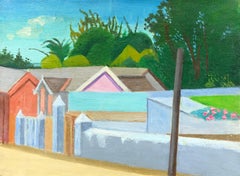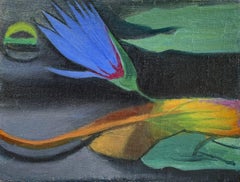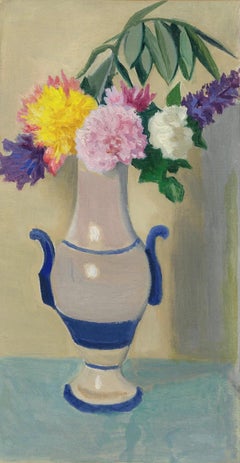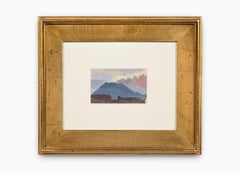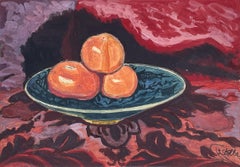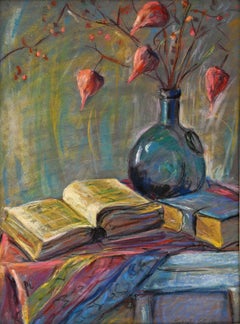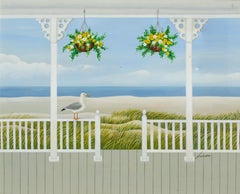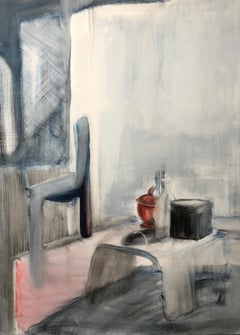Joseph Stella Paintings
Joseph Stella was a visionary artist who painted what he saw, an idiosyncratic and individual experience of his time and place. Stella arrived in New York in 1896, part of a wave of Italian immigrants from poverty-stricken Southern Italy. But Stella was not a child of poverty. His father was a notary and respected citizen in Muro Lucano, a small town in the southern Apennines. The five Stella brothers were all properly educated in Naples. Stella’s older brother, Antonio, was the first of the family to come to America. Antonio Stella trained as a physician in Italy, and was a successful and respected doctor in the Italian community centered in Greenwich Village. He sponsored and supported his younger brother, Joseph, first sending him to medical school in New York, then to study pharmacology, and then sustaining him through the early days of his artistic career. Antonio Stella specialized in the treatment of tuberculosis and was active in social reform circles. His connections were instrumental in Joseph Stella’s early commissions for illustrations in reform journals.
Joseph Stella, from the beginning, was an outsider. He was of the Italian-American community, but did not share its overwhelming poverty and general lack of education. He went back to Italy on several occasions, but was no longer an Italian. His art incorporated many influences. At various times his work echoed the concerns and techniques of the so-called Ashcan School, of New York Dada, of Futurism and, of Cubism, among others. These are all legitimate influences, but Stella never totally committed himself to any group. He was a convivial, but ultimately solitary figure, with a lifelong mistrust of any authority external to his own personal mandate. He was in Europe during the time that Alfred Stieglitz established his 291 Gallery. When Stella returned he joined the international coterie of artists who gathered at the West Side apartment of the art patron Conrad Arensberg. It was here that Stella became close friends with Marcel Duchamp.
Stella was 19 when he arrived in America and studied in the early years of the century at the Art Students League, and with William Merritt Chase, under whose tutelage he received rigorous training as a draftsman. His love of line, and his mastery of its techniques, is apparent early in his career in the illustrations he made for various social reform journals. Stella, whose later work as a colorist is breathtakingly lush, never felt obliged to choose between line and color. He drew throughout his career, and unlike other modernists, whose work evolved inexorably to more and more abstract form, Stella freely reverted to earlier realist modes of representation whenever it suited him. This was because, in fact, his “realist” work was not “true to nature,” but true to Stella’s own unique interpretation. Stella began to draw flowers, vegetables, butterflies, and birds in 1919, after he had finished the Brooklyn Bridge series of paintings, which are probably his best-known works. These drawings of flora and fauna were initially coincidental with his fantastical, nostalgic and spiritual vision of his native Italy which he called Tree of My Life (Mr. and Mrs. Barney A. Ebsworth Foundation and Windsor, Inc., St. Louis, illus. in Barbara Haskell, Joseph Stella, exh. cat. [New York: Whitney Museum of American Art, 1994], p. 111 no. 133).
(Biography provided by Hirschl & Adler)
1930s American Modern Joseph Stella Paintings
Canvas, Oil
20th Century Modern Joseph Stella Paintings
Oil
20th Century Modern Joseph Stella Paintings
Oil
Late 20th Century American Modern Joseph Stella Paintings
Canvas, Oil
Mid-20th Century American Modern Joseph Stella Paintings
Paper, Gouache, Graphite
1920s Futurist Joseph Stella Paintings
Pastel
1940s American Modern Joseph Stella Paintings
Canvas, Oil
1920s American Modern Joseph Stella Paintings
Canvas, Oil
20th Century Modern Joseph Stella Paintings
Oil
Early 20th Century American Modern Joseph Stella Paintings
Canvas, Oil
1910s Futurist Joseph Stella Paintings
Gouache, Paper
1930s Post-Impressionist Joseph Stella Paintings
Pastel
Late 20th Century American Modern Joseph Stella Paintings
Canvas, Oil
Late 20th Century Modern Joseph Stella Paintings
Oil
1950s American Modern Joseph Stella Paintings
Canvas, Oil
1960s American Modern Joseph Stella Paintings
Canvas, Oil, Illustration Board
1970s Modern Joseph Stella Paintings
Paper, Gouache
1960s Modern Joseph Stella Paintings
Oil
Mid-20th Century Modern Joseph Stella Paintings
Oil
1960s American Modern Joseph Stella Paintings
Canvas, Oil, Illustration Board, Newsprint
Mid-20th Century Modern Joseph Stella Paintings
Paper, Gouache
Mid-20th Century American Modern Joseph Stella Paintings
Canvas, Oil
1920s American Modern Joseph Stella Paintings
Oil, Canvas, Illustration Board
1950s Joseph Stella Paintings
Watercolor, Laid Paper, Graphite
Early 20th Century American Modern Joseph Stella Paintings
Canvas, Oil
Joseph Stella paintings for sale on 1stDibs.
Artists Similar to Joseph Stella
- What is Joseph Stella known for?1 Answer1stDibs ExpertOctober 15, 2024Joseph Stella is known for his work as an artist. He was a visionary artist who painted what he saw: an idiosyncratic and individual experience of his time and place. Stella was 19 when he arrived in the United States and studied in the early years of the century at the Art Students League and with William Merritt Chase, under whose tutelage he received rigorous training as a draftsman. His love of line and his mastery of its techniques are apparent in his early illustrations for various social reform journals. Stella, whose later work as a colorist is breathtakingly lush, never felt obliged to choose between line and color. He drew throughout his career, and unlike other modernists, whose work evolved to more and more abstract forms, Stella freely reverted to earlier realist modes of representation whenever it suited him. Some of his most famous works include Battle of Lights, Coney Island, Mardi Gras; The Brooklyn Bridge: Variation on an Old Theme and Flowers, Italy. Shop a selection of Joseph Stella art on 1stDibs.
- 1stDibs ExpertAugust 29, 2024No, Frank Stella was not related to Joseph Stella. While it's possible that in-depth genealogical research may uncover a shared ancestor many generations ago, the two artists are not currently believed to be related. Joseph Stella was born in 1877 in Muro Lucano, Italy, while Frank Stella was born in 1936 in Malden, Massachusetts. On 1stDibs, shop a diverse assortment of Frank Stella and Joseph Stella art.
- 1stDibs ExpertAugust 29, 2024Opinions differ about what kind of artist Joseph Stella was. At various times, his work echoed the concerns and techniques of the so-called Ashcan School, New York Dada, Futurism and Cubism, among others. These are all legitimate influences, but Stella never totally committed himself to any group. Some people also associate him with the American Precisionist movement, which emerged after World War I and explored industrialization and urbanization themes. Shop a diverse assortment of Joseph Stella art on 1stDibs.
- 1stDibs ExpertAugust 29, 2024Joseph Stella first painted the Brooklyn Bridge in 1918. He actually returned to the subject numerous times, completing additional paintings of the landmark in 1918, 1920, 1939 and 1941. Examining these paintings side by side shows how Stella's style became more and more abstract over the course of his career. Explore an assortment of Joseph Stella art on 1stDibs.
